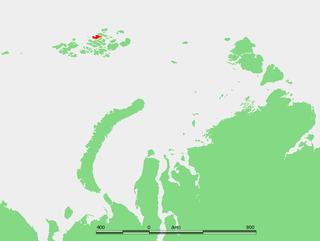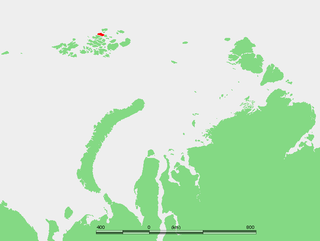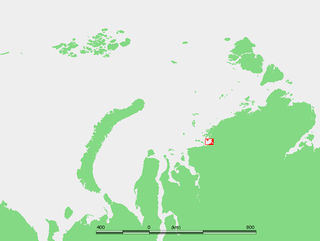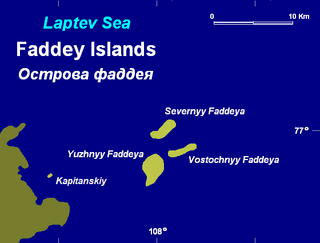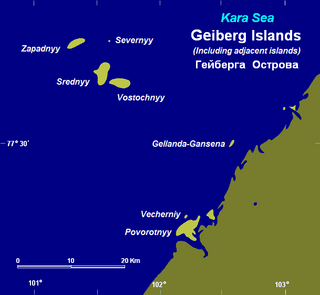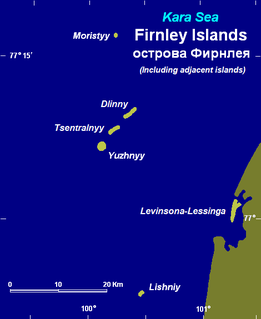 The Saint Peter Islands at the northeastern end of the Taymyr Peninsula | |
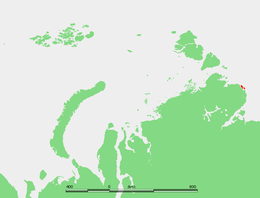 | |
| Geography | |
|---|---|
| Location | Laptev Sea |
| Coordinates | 76°35′N113°0′E / 76.583°N 113.000°E Coordinates: 76°35′N113°0′E / 76.583°N 113.000°E |
| Archipelago | Saint Peter Islands |
| Total islands | 19 |
| Administration | |
Russia | |
| Krai | Krasnoyarsk Krai |
| Demographics | |
| Population | uninhabited |
The Saint Peter Islands, also known as Saint Petra Islands or Petra Islands (Russian : Острова Петра, Ostrova Petra) are two islands covered with tundra vegetation, shingle and ice. These islands, as well as some other islands nearby (Ostrova Andreia, Ostrov Pavla) were originally named after Christian Apostles. The climate is Arctic and severe with frequent blizzards in the winter. The sea surrounding these Islands is covered with fast ice most of the year and is obstructed by pack ice even in the summer, so that these islands are merged with the mainland and animals can go across the ice. [1]

Russian is an East Slavic language, which is official in the Russian Federation, Belarus, Kazakhstan and Kyrgyzstan, as well as being widely used throughout Eastern Europe, the Baltic states, the Caucasus and Central Asia. It was the de facto language of the Soviet Union until its dissolution on 25 December 1991. Although, nowadays, over two decades after the breakup of the Soviet Union, Russian is used in official capacity or in public life in all the post-Soviet nation-states, as well as in Israel and Mongolia, the rise of state-specific varieties of this language tends to be strongly denied in Russia, in line with the Russian World ideology.

In physical geography, tundra is a type of biome where the tree growth is hindered by low temperatures and short growing seasons. The term tundra comes through Russian тундра from the Kildin Sami word тӯндар meaning "uplands", "treeless mountain tract". Tundra vegetation is composed of dwarf shrubs, sedges and grasses, mosses, and lichens. Scattered trees grow in some tundra regions. The ecotone between the tundra and the forest is known as the tree line or timberline.

A shingle beach is a beach which is armoured with pebbles or small- to medium-sized cobbles. Typically, the stone composition may grade from characteristic sizes ranging from 2 to 200 millimetres diameter.
Contents
This island group belongs to the Krasnoyarsk Krai administrative division of Russia. None of these islands have had much historical importance, except for the fact that they are located very close to the Northern Sea Route. [2]

Krasnoyarsk Krai is a federal subject of Russia, with its administrative center in the city of Krasnoyarsk—the third-largest city in Siberia. Comprising half of the Siberian Federal District, Krasnoyarsk Krai is the largest krai in the Russian Federation, the second largest federal subject and the third largest subnational governing body by area in the world, after Sakha and the Australian state of Western Australia. The krai covers an area of 2,339,700 square kilometers (903,400 sq mi), which is nearly one quarter the size of the entire country of Canada, constituting roughly 13% of the Russian Federation's total area and containing a population of 2,828,187, or just under 2% of its population, per the 2010 Census.

The Northern Sea Route is a shipping route officially defined by Russian legislation as lying east of Novaya Zemlya and specifically running along the Russian Arctic coast from the Kara Sea, along Siberia, to the Bering Strait. The entire route lies in Arctic waters and within Russia's exclusive economic zone (EEZ). Parts are free of ice for only two months per year. The overall route on Russia's side of the Arctic between North Cape and the Bering Strait has been called the Northeast Passage, analogous to the Northwest Passage on the Canada side.




